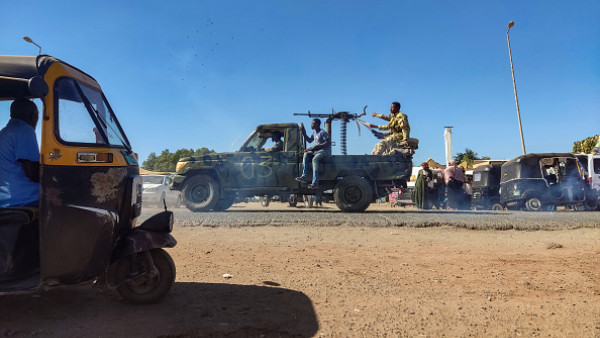‘Crimes against humanity’ maybe committed in Sudan: UN chief
'Crimes against humanity' maybe committed in Sudan: UN chief The New Arab


Indiscriminate Attacks in Sudan Could Constitute War Crimes and Crimes Against Humanity, Says UN Secretary-General

Tens of thousands are believed to have been killed in the fighting, but no official figures exist [Getty]
Introduction
UN Secretary-General Antonio Guterres stated on Monday that indiscriminate attacks against civilians in Sudan could potentially be classified as “war crimes and crimes against humanity.” This statement comes one year after the eruption of fighting between rival generals in the country.
The Impact on the Sudanese People
Guterres emphasized that the conflict in Sudan is not merely a battle between two parties, but rather a war being waged against the Sudanese people. He highlighted the devastating consequences, with tens of thousands of individuals killed and 18 million facing acute hunger.
War Crimes and Crimes Against Humanity
Guterres condemned the indiscriminate attacks that result in the killing, injury, and terrorization of civilians. He expressed particular concern regarding the use of sexual violence against women and girls, as well as attacks on aid convoys. Such actions could potentially amount to war crimes and crimes against humanity.
Escalating Unrest in Darfur
Guterres also raised concerns about reports of escalating unrest in El-Fasher, a city in the western region of Darfur. This region, which is home to a quarter of Sudan’s population, has previously experienced horrific violence, including mass ethnic-based killings. El-Fasher is currently the only state capital not under the control of the paramilitary Rapid Support Forces (RSF), who are engaged in battle with Sudan’s army. Additionally, it serves as a crucial hub for humanitarian aid.
Resurgence of Sexual and Ethnic-Based Violence
Fears have arisen regarding the resurgence of sexual and ethnic-based violence in Darfur due to the outbreak of civil war. Guterres reported that RSF-affiliated militias recently attacked and burned villages west of El-Fasher, resulting in widespread displacement. There are also concerns that the city’s only water source could be overtaken. Ongoing fighting on the outskirts of El-Fasher further exacerbates the situation.
Potential Consequences
Guterres warned that an attack on El-Fasher would have devastating consequences for civilians and could potentially lead to full-blown intercommunal conflict across Darfur. Such an attack would also disrupt aid operations in an area that is already on the brink of famine.
SDGs, Targets, and Indicators
| SDGs | Targets | Indicators |
|---|---|---|
SDG 16: Peace, Justice, and Strong Institutions |
|
|
SDG 2: Zero Hunger |
|
|
1. Which SDGs are addressed or connected to the issues highlighted in the article?
SDG 16: Peace, Justice, and Strong Institutions
The article discusses indiscriminate attacks against civilians in Sudan, which could constitute war crimes and crimes against humanity. This is directly connected to SDG 16, which aims to promote peace, justice, and strong institutions.
SDG 2: Zero Hunger
The article mentions that 18 million people in Sudan are facing acute hunger. This highlights the issue of hunger and food insecurity, which is addressed by SDG 2.
2. What specific targets under those SDGs can be identified based on the article’s content?
Target 16.1: Reduce violence and related death rates
The article mentions indiscriminate attacks against civilians, which contribute to violence and death rates.
Target 16.3: Promote the rule of law at the national and international levels and ensure equal access to justice for all
The article highlights the need to address war crimes and crimes against humanity, promoting the rule of law and ensuring equal access to justice.
Target 16.4: By 2030, significantly reduce illicit financial and arms flows, strengthen the recovery and return of stolen assets, and combat all forms of organized crime
Although not explicitly mentioned in the article, the conflict in Sudan involves armed groups and potential illicit financial flows, which are relevant to this target.
Target 2.1: By 2030, end hunger and ensure access by all people, in particular, the poor and people in vulnerable situations, including infants, to safe, nutritious, and sufficient food all year round
The article highlights the issue of acute hunger faced by 18 million people in Sudan, which aligns with this target.
Target 2.2: By 2030, end all forms of malnutrition, including achieving, by 2025, the internationally agreed targets on stunting and wasting in children under 5 years of age, and address the nutritional needs of adolescent girls, pregnant and lactating women, and older persons
Although not explicitly mentioned in the article, the issue of hunger and malnutrition is relevant to this target.
3. Are there any indicators mentioned or implied in the article that can be used to measure progress towards the identified targets?
The article does not explicitly mention any indicators. However, based on the issues discussed, the following indicators can be used to measure progress towards the identified targets:
Indicator 16.1.1: Number of intentional homicides per 100,000 population
This indicator can be used to measure progress towards reducing violence and related death rates.
Indicator 16.3.1: Proportion of victims of violence in the previous 12 months who reported their victimization to competent authorities or other officially recognized mechanisms for the prevention and redress of violence and their families
This indicator can be used to measure progress towards promoting the rule of law and ensuring equal access to justice.
Indicator 16.4.1: Total value of inward and outward illicit financial flows (in current United States dollars)
This indicator can be used to measure progress towards reducing illicit financial flows.
Indicator 2.1.1: Prevalence of undernourishment
This indicator can be used to measure progress towards ending hunger and ensuring access to sufficient food.
Indicator 2.2.1: Prevalence of stunting (height for age <-2 standard deviation from the median of the World Health Organization (WHO) Child Growth Standards) among children under 5 years of age
This indicator can be used to measure progress towards ending all forms of malnutrition.
Indicator 2.2.2: Prevalence of malnutrition (weight for height >+2 or <-2 standard deviation from the median of the WHO Child Growth Standards) among children under 5 years of age, by type (wasting and overweight)
This indicator can be used to measure
Behold! This splendid article springs forth from the wellspring of knowledge, shaped by a wondrous proprietary AI technology that delved into a vast ocean of data, illuminating the path towards the Sustainable Development Goals. Remember that all rights are reserved by SDG Investors LLC, empowering us to champion progress together.
Source: newarab.com

Join us, as fellow seekers of change, on a transformative journey at https://sdgtalks.ai/welcome, where you can become a member and actively contribute to shaping a brighter future.







